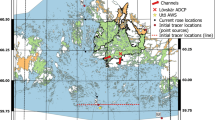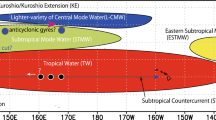Abstract
Modelling of Late Quaternary paleoceanography and sedimentation in the northern North Atlantic (NNA) is achieved by coupling the ocean general circulation model SCINNA (Sensitivity and Circulation In the NNA) to the sedimentation models SENNA (Sedimentation In the NNA) and PATRINNA (PArticle Tracing In the NNA).
SCINNA is based on the primitive equations with conservation of mass, momentum, energy, heat and salt. SENNA and PATRINNA are driven by temperature, salinity and velocity fields derived from SCINNA. The modelling includes three-dimensional circulation of the ocean, sediment transport in the water column and two-dimensional sedimentary processes in a thin bottom layer. SENNA calculates the erosion, transport and deposition of sediments, resulting in sedimentation patterns for specific time intervals. PATRINNA models the transport paths of single sediment grains corresponding to the ocean circulation.
The NNA reacts in a highly sensitive manner to small forcing changes, as shown by our sensitivity experiments. From these experiments it is possible to model specific circulation regimes for glacial and interglacial periods, for melt water events and for the onset of glaciation. The different climatic stages in the circulation model produce different sediment patterns in the sedimentation models, which correspond closely to the sedimentary record.
Similar content being viewed by others
References
Aukrust T, Oberhuber JM. Modelling of the Greenland, Iceland and Norwegian Seas with a coupled sea ice-mixed layer-isopycnal ocean model. J Geophy Res, in press
Bitzer K, Pflug R (1990) DEPOD: a three-dimensional model for simulating elastic sedimentation and isostatic compensation in sedimentary basins. In: Cross TA (ed) Quantitative Dynamics Stratigraphy. Prentice Hall, Englewood Cliffs, pp 335–348
Broecker W, Peng T-H (1982) Tracers in the Sea. Eldigio Press, Palisades, 689 pp
Bryan K (1969) A numerical method for the studys of the circulation of the world ocean. J Comp Phys 4:347–376
CLIMAP Project Members (1981) Seasonal Reconstructions of the Earth's Surface at the Last Glacial Maximum. GSA Map Chart Ser MC-36. Geological Society of America, Boulder
Cox MD (1984) A primitive equation, 3-dimensional model of the ocean. GFDL Ocean Group Tech Rep No 1. Geophysical Fluid Dynamics Laboratory / NOAA, Princeton University, 104 pp
Dietrich G (1969) Atlas of the Hydrography of the Northern North Atlantic. Conseil International pour l'Exploration de la Mer, Service Hydrographique, Charlottenlund Slot
Duplessy J-C, Labeyrie L, Juillet-Leclerc A, Maitre F, Dupart J, Sarnthein M (1991) Surface salinity reconstruction of the North Atlantic during the Last Glacial Maximum. Oceanol Acta 14:311–324
Ericksen M-C, Masson DS, Slingerland R, Swetland DW (1989) Numerical Simulation of Circulation and Sediment Transport in the Late Devonian Catskill Sea. In: Quantitative Dynamics Stratygraphy; Cross TA (ed), Prentice Hall, Englewood Cliffs, pp 293–305
Gibbs RJ (1985) Settling velocity, diameter, and density for flocs of illite, kaolinite, and montmorillonite. J Sedim Petrol 55:65–68
Hellerman S, Rosenstein M (1983) Normal monthly wind stress over the world ocean with error estimates. J Phys Oceanogr 13:1093–1104
Hjulstrom F (1939) Transportation of detritus by moving water. In: Trask PD (ed) Recent Marine Sediments. American Association of Petroleum Geologists, Tulsa, pp 5–41
Honjo S (1990) Particle fluxes and modern sedimentation in the polar oceans. In: Smith WO (ed) Polar Oceanography, Part B, Academic Press, Inc., San Diego, New York, Boston, London, Sydney, Tokyo, Toronto, pp 687–739
Kendall CGStC, Moore P, Strobel J, Cannon R, Perlmutter M, Bezdek J, Biswas G. Simulation of the Sedimentary Fill of Basins; Kansas Geological Survey Bulletin, Vol 233, pp 9–30
Krohn J (1975) Ein mathematisches Modell des großräumigen gezeitenbedingten Sedimenttransports mit Anwendung auf die Nordsee. Master Thesis, Institut fur Meereskunde, Hamburg
Lee Y-H, Harbaugh JW (1992) Stanford's SEDSIM Project. Dynamic three-dimensional simulation of geologic processes that affect elastic sediments. In: Pflug R, Harbaugh JW (eds) Computer Graphics in Geology. Lecture Notes Earth Sci 41. Springer, Berlin, Heiidelberg, New York, pp 113–127
Legutke S (1991) Numerical experiments relating to the Great Salinity Anomaly of the seventies in the Greenland and Norwegian Seas. Progr Oceanogr 27:341–363
Levitus S (1982) Climatological Atlas of the World Ocean. NOAA Prof Pap 13. US Government Printing Office, Washington, 173 pp
McCave IN (1984) Erosion, transport and deposition of finegrained marine sediments. In: Stow DA, Piper DJ (eds) Finegrained Sediments: Deep-water Processes and Facies. Geological Society/Blackwell Scientific, Oxford pp 35–69
McCave IN, Gross TF (1991) In-situ measurements of particle settling velocity in deep sea. Mar Geol 99:403–411
McCave IN, Tucholke BE (1986) Deep current controlled sedimentation in the western North Atlantic. In: Vogt PR, Tucholke BE (eds) The Geology of North America, Vol M. Geological Society of America, Boulder, pp 451–468
Mesinger F, Arakawa A (1976) Numerical Methods Used in Atmospheric Models. GARP Publ Ser 17:64 pp
Miller MC, McCave IN, Komar PD (1977) Threshold of sediment motion under unidirectional currents. Sedimentology 24:507–528
Pacanowski R, Dixon K, Rosati A (1991, 1993) The G.F.D.L. Molecular Ocean Model Users Guide. GFDL Ocean Group Tech Rep 2
Pflaumann U, Duprat J, Pujol C, Labeyrie D. SIMMAX, a transfer technique to deduce Atlantic sea surface temperatures from planktonic foraminifera — the EPOCH approach. Paleoceanography, submitted
Puls W (1981) Numerical simulation of bedform mechanics. Mitteilungen Inst Meereskunde Univ Hamburg 24:1–147
Sarnthein M, Jansen E, Arnold M, Duplessy J-C, Erlenkeuser H, Flatoy A, Veum T, Vogelsang E, Weinelt MS (1992) A timeslice reconstruction of meltwater anomalies at termination I in the North Atlantic between 50 and 80 N. In: Bard E, Broecker WS (edS) The Last Deglaciation: Absolute and Radiocarbon Chronologies. NATO ASI Ser 12. Springer, Berlin, Heidelberg, New York, pp 183–200
Sarnthein M, Winn K, Jung S, Duplessy J-C, Labeyrie L, Erlenkeuser H, Ganssen G (1994) Changes in East Atlantic deepwater circulation over the last 30000 years: Eight time slice reconstructions. Paleoceanography, Vol 9, No 2, pp 209–267
Seidov D, Sarnthein M, Stattegger K (1994) Toward a better understanding of the meltwater event near 13.6 ky by — a numerical modelling approach, in preparation
Stevens DP (1991) A numerical ocean circulation model of the Norwegian and Greenland Sea. Progr Oceanogr 27:365–402
Sundermann J, Klöcker R (1983) Sediment transport modelling with applications to the North Sea. In: Sundermann J, Lenz W (eds) North Sea Dynamics. Springer, Berlin, Heidelberg, New York, pp 453–471
Syvitski JPM, Daughney S (1992) Delta 2: Delta Progadation and Basin Filling, Computer & Geosciences, Vol 18, No 7, pp 839–897
Tetzlaff DN, Harbaugh JW (1989) Simulating Clastic Sedimentation. Van Nostrand Reinhold, New York, 202 pp
Zanke U (1977) Berechnung von Sinkgeschwindigkeiten von Sedimenten. Mitteilungen Franzius Inst Wasserbau Küsteningenieurswesen Tech Univ Hannover 46:230–245
Zanke U (1978) Zusammenhänge zwischen Strömung und Sedimenttransport; Teil 1: Berechnung des Sedimenttransportes — allgemeiner Fall. Mitteilungen Franzius Inst Wasserbau Küs-teningenieurswesen Tech Univ Hannover 47:214–345
Author information
Authors and Affiliations
Rights and permissions
About this article
Cite this article
Haupt, B.J., Schäfer-Neth, C. & Stattegger, K. Three-dimensional numerical modeling of Late Quaternary paleoceanography and sedimentation in the northern North Atlantic. Geol Rundsch 84, 137–150 (1995). https://doi.org/10.1007/BF00192246
Received:
Accepted:
Issue Date:
DOI: https://doi.org/10.1007/BF00192246




